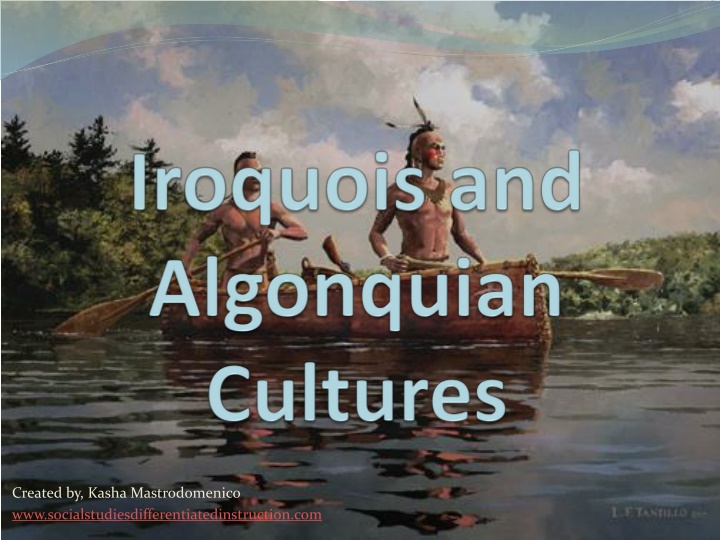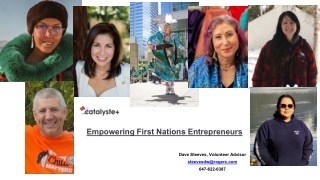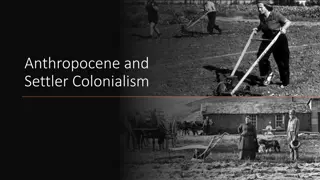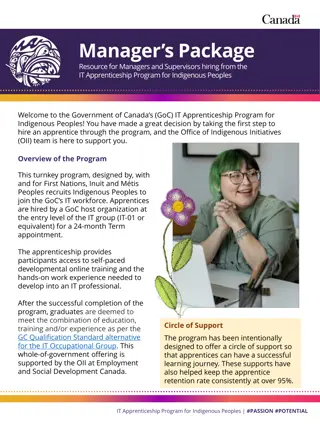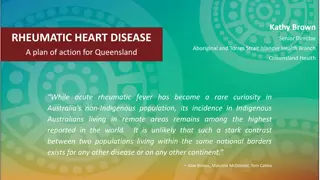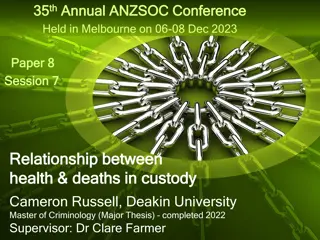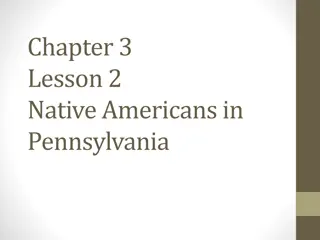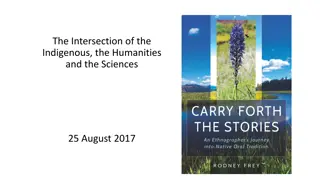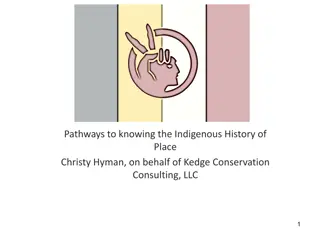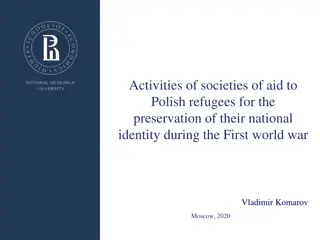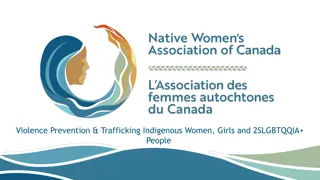Indigenous Cultures of New York: Iroquois and Algonquian Societies
Exploring the similarities and differences between the Iroquois and Algonquian cultures in New York, their settlement patterns, and the significance of nature in their societies. The Iroquois settlements were larger and featured longhouses, while the Algonquian settlements had smaller wigwams. Both cultures valued nature and had unique social structures.
Download Presentation

Please find below an Image/Link to download the presentation.
The content on the website is provided AS IS for your information and personal use only. It may not be sold, licensed, or shared on other websites without obtaining consent from the author.If you encounter any issues during the download, it is possible that the publisher has removed the file from their server.
You are allowed to download the files provided on this website for personal or commercial use, subject to the condition that they are used lawfully. All files are the property of their respective owners.
The content on the website is provided AS IS for your information and personal use only. It may not be sold, licensed, or shared on other websites without obtaining consent from the author.
E N D
Presentation Transcript
Created by, Kasha Mastrodomenico www.socialstudiesdifferentiatedinstruction.com
Essential Questions What are the similarities between the Iroquois and the Algonquian cultures? What are the differences between the Iroquois and the Algonquian cultures? Why is nature so important to both cultures? Where were the Iroquois and Algonquian cultures located in NYS?
Vocabulary Palisades: A high fence made of stakes used for defense Monotheism: Belief in one God Polytheism: Belief in more than one God Matriarchy: Society that follows the mothers line and where women have high importance in politics Natural Resources: Something that can be used by humans that comes from nature like forests and water Tribe: A group of people with common ancestry, culture, traditions and leaders Culture: behaviors and beliefs of a group of people
Iroquois Settlements Close to a water source Secured by long palisades 300-600 people per village Long houses Acres of fields for crops inside and outside of palisades Trails connected settlements
Algonquian Settlements Homes: wigwams, 8-10 feet high Close to a water source Trails connected settlements Averaged 10 people in a wigwam Secured by long palisades Surrounded by growing fields
Who Are the Iroquois and Algonquians? Algonquians Iroquois Iroquois means real snakes and is an Algonquian word (they were enemies) Originally: Kanonsionni - people of the longhouse Now: Haudenosaunee - 6 separate Indian nations: Seneca, Cayuga, Onondaga, Oneida, Mohawk, Tuscarora Algonquian doesn t mean anything. It was made up by anthropologists to describe a linguistic family. Tribes in NY include: Mohican, Mohegan, Munsee Delaware, Abenaki, and Poospatuck
Creation and Religious Beliefs (Iroquois) Creation story Monotheism: God was Great Spirit or "Ha-wen-ne-yu" with invisible agents, "Ho-no-che-no-keh , that did his will on earth. The 3 Sisters were important spirits in charge of maize, beans and squash. The Great Spirit s brother, "Ha-ne-go- ate-geh , was evil and controlled his own evil spirits or invisible agents. The believers had to choose to follow the Great Spirit or submit to evil. Believed in an immortal soul that was judged after death Festivals and ceremonies were conducted mostly during agricultural seasons to give thanks for protection and survival. Burning tobacco carried their prayers to the Great Spirit. Practiced dream interpretation
Creation & Religious Beliefs (Algonquian) Since the Algonquian tribes were not united, they each had their own religious beliefs Story Mohegan s believed in a Great Spirit with lesser spirits Monotheistic Believe that earth was created atop of giant turtle s back Held Green Corn Festival Abenaki Main God Glooskap Polytheistic Believed in a monster named Pamola who lived on top of Mount Katahdin Gluskabe was a trickster. They also believed that people could leave their bodies and enter the realm of the supernatural, usually in animal forms
Importance of the Laws of Nature and the Wise use of Natural Resources (Iroquois and Algonquian) All tools (animal bones, stones, sinew from deer helped to create bows), food (plants, fruits, animals, fish), clothing (skins and furs), and shelter (parts of trees made homes) came from the natural environment. Bowls and cooking tools were made of clay, animal bones and rocks. Lived near water that provided them fishing, transportation, and drinking water
Gender Roles Iroquois Algonquian Women: keeper of culture, responsible for educating youth using oral tradition and life skills until the age of 12, tended crops, appointed political leaders, head of household, owner of property, social structure followed mothers family line including the clan the children were raised in as well as the last name, made clothing and food, clan mothers, in charge of festivals Men: hunters and fisherman, taught boys how to do those life skills, warriors, chiefs, traveled between tribes, and trading, collected herbs and made basic medicine, shamans Mohegan: Men: cleared new corn fields, cut wood for the palisades, made canoes, hunted Women: tended the corn fields with the help of children, gathered roots and berries Both men and women gathered and processed fish and shellfish. Family line and land ownership followed both males and females Abenaki: Men: hunters, fishermen, leaders, and shamans Women: gatherers, hide workers and curers patrilineal Both the Mohegan and Abenaki had polygamy in their culture but not everyone had multiple wives.
Family and Kinship and Education Iroquois Algonquian Mohegan: Boys learned fishing, hunting, and competed in sports. Girls learned crafts. Discipline was verbal. Abenaki: Adoption was common. Adults were teachers and not punishers. Boys were taught to hunt, fish, and provide for the family. Girls were taught to take care of babies, cook, and make clothing. No other child would be born until the previous child reached the age of 5, if a child was born before that, adoption was honorable and common. Adults wouldn t intervene unless a child was in danger and allowed them to learn from their own mistakes. Corporal punishment, spanking or hitting, was not done. A child may be reprimanded by the parent and then was reprimanded by others in the community which was embarrassing. They were praised when they did well by all in the community. If a child was really disobedient, water would be thrown in their face with no threat of drowning. Children were considered adults at the age of 12 and split into gender education through mentors. (boys hunting, fishing and girls crafts and field tending and homemaking) Boys played lacrosse
Language Iroquois Algonquian Hear the languages All Iroquois belong to the Iroquoian language family. In NYS these branches of the language were spoken: Hear the Mohegan language All Algonquian tribes belong to the Algonquian language family. In NYS each Algonquian tribe spoke a similar language but had unique aspects. Northern Iroquoian branch: Tuscarora 5 Nations Group: Onondaga, Seneca, Cayuga, Mohawk, and Oneida
Essential Questions What are the similarities between the Iroquois and the Algonquian cultures? What are the differences between the Iroquois and the Algonquian cultures? Why is nature so important to both cultures? Where were the Iroquois and Algonquian cultures located in NYS?
